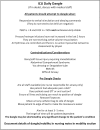A team approach to the introduction of safe early mobilisation in an adult critical care unit
- PMID: 30515467
- PMCID: PMC6231105
- DOI: 10.1136/bmjoq-2018-000339
A team approach to the introduction of safe early mobilisation in an adult critical care unit
Abstract
Delirium and intensive care unit acquired weakness are common in patients requiring critical care and associated with higher mortality and poor long-term outcomes. Early mobilisation has been shown to reduce the duration of both conditions and is recommended as part of a strategy of rehabilitation of critically ill patients starting during their stay in intensive care. Our aim was to achieve 95% reliability with a standardised mobilisation process. Multidisciplinary involvement through the use of regular focus groups lead to the development of a standardised process of sitting a ventilated or non-ventilated patient at the side of the bed for a set period of time, which was called the daily dangle. Team learning from Plan, Do, Study, Act (PDSA)cycles, as well as feedback from both staff and patients, allowed us to develop the process and achieve a median 87% reliability. Delirium rates fell from 54.1% to 28.8%. There was no change in average length of stay, and no adverse events. Ownership by the staff, development of the process by staff, iterative testing and learning, and designs for reliability were the factors behind the successful adoption of a new and challenging process. Particular changes which drove reliability were standardisation of the criteria for a dangle, standardisation of the dangle itself and a reminder included on the daily goals checklist.
Keywords: Continuous Quality Improvement; Critical Care; Pdsa; Quality Improvement; Teams.
Conflict of interest statement
Competing interests: None declared.
Figures








References
-
- Levels of critical care for adult patients. Intensive Care Society UK, 2009. https://www.ics.ac.uk/ICS/guidelines-and-standards.aspx
-
- Ely EW, Inouye SK, Bernard GR, et al. . Delirium in mechanically ventilated patients: validity and reliability of the confusion assessment method for the intensive care unit (CAM-ICU). JAMA 2001;286:2703–2010. - PubMed
-
- Delirium: prevention, diagnosis and management. National Institute of health and care excellence, 2010. https://www.nice.org.uk/Guidance/CG103
LinkOut - more resources
Full Text Sources
